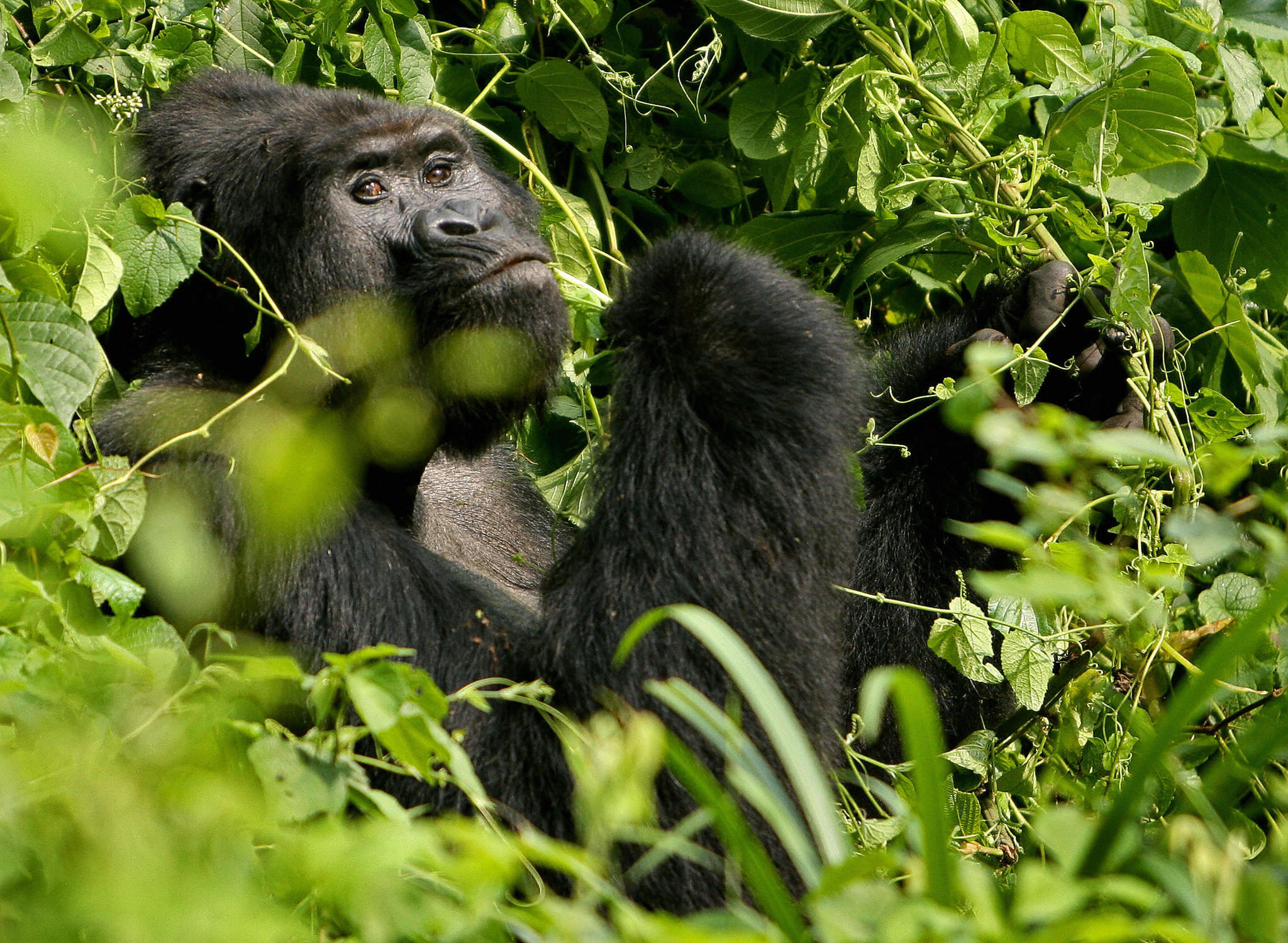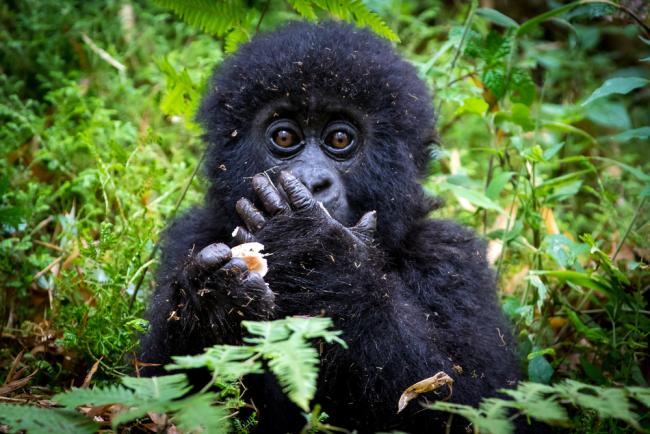13 Facts About Mountain Gorillas in Africa : The mountain gorillas are unique and endangered primate species which are a major attraction on the African continent. Tourists who need to see these mountain gorillas can have a gorilla safari within 3 countries of Uganda, Rwanda and democratic republic of Congo. Trekking the mountain gorillas in these countries is so amazing and adventurous thus giving a memorable experience.
1. WHAT ARE MOUNTAIN GORILLAS
Mountain gorillas are known to be the largest primate species in the world and are one of the two subspecies of the eastern gorilla known as gorilla beringei and the other is the eastern lowland gorilla. These live in the dense forests of central and western countries of Africa.
2. PHYSICAL DESCRIPTION OF A MOUNTAIN GORILLA
The mountain gorillas are 1 to 2 meters tall which means that they can reach a height of 4 to 6 feet. The mountain gorillas are hairy primates, with longer hair and shorter arms as compared to the eastern gorillas. The apes have broad chests and muscular arms with thick black hair.
3. SOCIAL LIFESTYLE OF MOUNTAIN GORILLAS IN AFRICA
Mountain gorillas are social mammals and live in groups of about 11 to 30 members led by a dominant silverback gorilla. A silverback is responsible for taking care of each and every member in its group, internal threats and it’s the one to mate the females in his group. Therefore it will fight the other male gorillas in his group as a way of preventing them from mating the females. Mountain gorillas are generally quiet and peaceful animals and never sleep in the same place for two consecutive nights because they are always on a move in search of food.
4. WHERE DO MOUNTAIN GORILLAS LIVE
Mountain gorillas live in the dense tropical rainforest of Uganda, Rwanda and democratic republic of Congo only. Therefore any tourist who loves to see mountain gorillas within their natural habitat has to pay for the gorilla trekking tour in the above countries. In Uganda mountain gorillas can be trekked from Bwindi impenetrable national park and Mgahinga gorilla national park, Volcanoes national park in Rwanda and Virunga national park in Congo
5. THE REPRODUCTIVE LIFE OF MOUNTAIN GORILLAS
Female gorillas have a gestation period of 257 days which is around 9 months. The female gorillas are sexually active at the age of 7 or 8 years and they start reproducing at 10 years and above. When the female gorilla starts breeding, she can give birth to one or two babies although it’s rare to give birth to twins. In most cases twin baby gorillas dies at birth or a few weeks after birth. But when the baby gorilla dies, the mother carries it for some time until she finally abandons the lifeless body of the infant gorilla. The female gorilla often gives birth to one baby every 4 to 6 years and only 3 or four babies over her life time. The slow rate of reproduction in mountain gorillas greatly affects the population numbers.
6. HOW MUCH DO MOUNTAIN GORILLAS WEIGH
Mountain gorillas are the world’s largest primates where the males weigh 120 kg to 220kg which is approximately 260-485 pounds. The females weigh 68 to 113kg which is 150 to 250 pounds. A fully grown male adult mountain gorilla weighs 136kgs with a silver back weighing about 195 to 220kgs. A full grown female mountain gorilla weighs 86 to 113kgs and a newly born gorilla weighs 3 to 5 pounds and are usually referred to as infants. Mountain gorillas live in groups/families which are led by a dominant adult male gorilla called a silverback. Silverbacks protect the members of the family especially the females and infant gorillas.

7. HOW SIMILAR ARE THEY TO HUMANS
Scientifically mountain gorillas have be proven to genetically share 98% of their DNA with human beings. That is why mountain gorillas can show human like characteristics and emotions such as remorse happiness and sadness. Mountain gorillas can be affected by diseases that are similar to those of humans such as flu, Ebola, cough and arthritis which affects their joints, fingers, hands and feet. Just like human beings mountain gorillas suffer from loss of teeth at an old age and thus affects their normal feeding routine as well as hard for a mountain gorilla to eat at a normal pace like others. Mountain gorillas as well mourn the loss of a member and can be seen gathering around the corpse of a dead gorilla, 13 Facts About Mountain Gorillas in Africa
8. WHAT IS THE LIFE SPAN OF MOUNTAIN GORILLAS IN AFRICA
While in the Wild Mountain gorillas can live for 40 to 50 years. However while in captivity such as zoo their life span can reach up to 60 years. The oldest western gorilla ever recorded alive was a female gorilla aged 60 years and died in 2017 at the Columbus zoo.
9. WHAT DO MOUNTAIN GORILLAS EAT
Mountain gorillas are mainly herbivorous animals and therefore their diet comprises plant stems, fruits, leaves, bamboo shoots and flowers. Mountain gorillas can eat half of their body weight which is 50 pounds of leafy foods per day. The mountain gorillas are partially omnivores as they can eat insects, snails and ants.
10. WHAT ARE THE MAJOR THREATS TO MOUNTAIN GORILLAS
There are many threats affecting the population of mountain gorillas in Africa and these include; diseases such as flu, Ebola and tuberculosis among others. Mountain gorilla population is as well threatened by poachers who hunt down the gorillas for bush meat so as to meet the high demand on the black market. Another major threat is habitat loss due to destruction of rainforests for timber, mining mineral ores, gas and as well create land for farming activities. Statistics have shown 17% of the total population of mountain gorillas currently living in the protected areas such as the national parks and forest reserves, 13 Facts About Mountain Gorillas in Africa
11. HOW DO MOUNTAIN GORILLAS COMMUNICATE WITH EACH OTHER
Mountain gorillas communicate with each other using different sounds and gestures such as screaming, barking, hooting, charging, belching, signing, yawning, and chest-beating among others. Each distinct sound that a gorilla makes has its meaning for instance when a gorilla charges it’s a warning sign of a threat. The American primatologist and conservationist Dian Fossey identified 17 different sounds made by mountain gorillas.
12. WHAT TO DO WHEN IN THE PRESENCE OF MOUNTAIN GORILLAS
Tourists on their gorilla trekking safari are given the rules and regulations on how to behave while in the presence of the mountain gorillas and these include;
-
Do not maintain eye contact with the gorillas
- Limit your movements while in the presence of the gorillas
- Maintain a distance of 7 meters away from the gorillas
- Do not trek gorillas if you have an airborne disease such as flu and cough.
- Do not eat, drink or smoke in the presence of the gorillas.
- Keep your voice down when in the presence of mountain gorillas
- Always stay calm when a gorilla charges, keep your head down and lie on the ground. Panicking will just worsen the situation.
- Don’t use flash on your camera or phone while taking pictures of the gorillas.
13. HOW MANY MOUNTAIN GORILLAS ARE LEFT IN AFRICA
The current population of mountain gorillas in Africa is estimated to be 1004 individuals, according to statics of the African wildlife foundation. The mountain gorillas can be found in the virunga massif where Bwindi impenetrable national park in Uganda has half of the world’s population of mountain gorillas in Africa.
